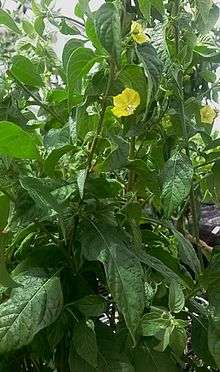Capsicum rhomboideum
| Capsicum rhomboideum | |
|---|---|
 | |
| Capsicum rhomboideum at flowering featuring yellow flowers. | |
| Scientific classification | |
| Kingdom: | Plantae |
| (unranked): | Angiosperms |
| (unranked): | Eudicots |
| (unranked): | Asterids |
| Order: | Solanales |
| Family: | Solanaceae |
| Genus: | Capsicum |
| Species: | C. rhomboideum |
| Binomial name | |
| Capsicum rhomboideum (Dunal) Kuntze | |
| Synonyms[1] | |
| |
Capsicum rhomboideum is a member of the genus Capsicum with 2n=2x=26, and is considered a distant wild relative of the Chili pepper. The fruit do not have any pungency, and are a 0 on the Scoville Heat Unit scale.[2][3] It gets its name from the rhomboidal to elliptical shape of its leaves.[4] It is a perennial that is capable of growing into a tree. It is native to Mexico, Central America, and Andean region of South America.[5][6]
Plant description
Capsicum rhomboideum is typically a small perennial herb. It is densely covered in trichomes, making it pubescent. It is best identified by its rhomboidal to elliptically-shaped leaves. The flowers have a five-toothed calyx and bell-shaped corolla that come in yellow.[5][7] The pollen grains are extremely small, 15 um.[8] Mature fruit of C. rhomboideum are pea-shaped and sized, bright red to black when fresh, and they darken as they dry. They typically bear 2-6 seed per fruit. The seeds are brown.[4]
Genome
The genome of C. rhomboideum is smaller than that of C. annuum. In the specific differentiation, C. rhomboideum likely underwent genome size reduction. Approximately 5% of the genome is heterochromatic.[6] The typical Capsicum has 2n=24, and since 2n=26 in C. rhomboideum , causing it to be reclassified from Capsicum ciliatum in 2001.[4]
See also
References
- ↑ http://fatalii.net/Chile_Peppers/Species/C_rhomboideum. Missing or empty
|title=(help) - ↑ Jarret, Robert L. (August 22, 2008). "DNA Barcoding in a Crop Genebank: The Capsicum annuum Species Complex" (PDF). The Open Biology Journal (1): 35–42.
- ↑ Russo, V. M. (2012-01-01). Peppers: Botany, Production and Uses. CABI. ISBN 9781845937843.
- 1 2 3 Barboza, Gloria E. (2011-02-11). "Lectotypifications, synonymy, and a new name in Capsicum (Solanoideae, Solanaceae)". PhytoKeys (2): 23–38. ISSN 1314-2011. PMC 3174431
 . PMID 22171173. doi:10.3897/PhytoKeys.2.730.
. PMID 22171173. doi:10.3897/PhytoKeys.2.730. - 1 2 Scaldaferro, Marisel A.; da Cruz, M. Victoria Romero; Cecchini, Nicolás M.; Moscone, Eduardo A. (2015-11-18). "FISH and AgNor mapping of the 45S and 5S rRNA genes in wild and cultivated species of Capsicum (Solananceae)". Genome. 59 (2): 95–113. ISSN 0831-2796. doi:10.1139/gen-2015-0099.
- 1 2 Moscone, Eduardo (2007). Spooner, ed. "The Evolution of Chili Peppers (Capsicum - Solanaceae): a Cytogenetic Perspective". Acta Hort. VI' International Solanaceae Conference.
- ↑ Barboza, Gloria E.; Bianchetti, Luciano De Bem. "Three New Species of Capsicum (Solanaceae) and a Key to the Wild Species from Brazil". Systematic Botany. 30 (4): 863–871. doi:10.1600/036364405775097905.
- ↑ Bo, María Laura; García, Carolina Carrizo (2015-01-02). "Pollen phenotyping and performance in rocoto chili (Capsicum pubescens Ruiz et Pav., Solanaceae)". Grana. 54 (1): 37–44. ISSN 0017-3134. doi:10.1080/00173134.2014.985606.